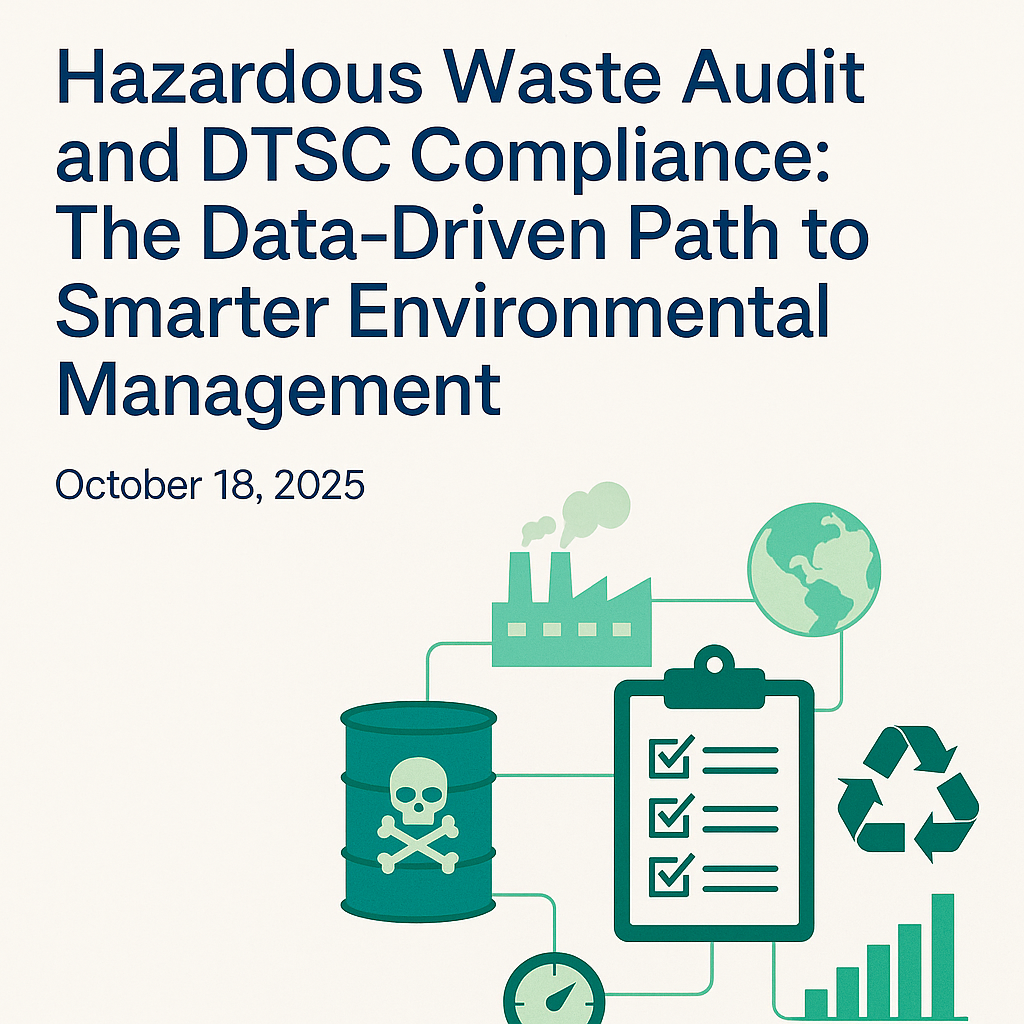By Dr. Stanley Njoku, Ph.D | October 18, 2025
💡 Why This Matters
Every business that handles chemicals or industrial materials produces some form of hazardous waste — and in California, that means navigating one of the strictest regulatory environments in the nation.
Whether you’re in biotech, manufacturing, or R&D, understanding your hazardous waste audit, DTSC compliance, and environmental consulting obligations isn’t just good practice — it’s essential for cost control, safety, and reputation.
⚖️ A Quick Look Back: The Law That Started It All
The Resource Conservation and Recovery Act (RCRA), enacted in 1976, established the EPA’s “cradle-to-grave” system — a framework ensuring every stage of hazardous waste management is accounted for, from generation to disposal.
California’s Department of Toxic Substances Control (DTSC) enforces these standards through its own set of even stricter state regulations, found under the California Health & Safety Code and Title 22 of the California Code of Regulations.
In short:
Federal law sets the floor — but California’s rules set the ceiling.
Hazardous Waste in California: The Scale of the Challenge
California generates millions of tons of hazardous waste annually, from:
- Biotech and pharmaceutical labs
- Automotive and aerospace industries
- Manufacturing plants and refineries
With this volume comes complexity — and cost. Businesses face multiple layers of fees and compliance obligations, including:
- DTSC Generator and Facility Fees
- Transportation and TSDF charges
- Treatment, destruction, and liability costs
- Reporting and documentation requirements
Managing all of these effectively requires a mix of technical expertise and data intelligence — areas where traditional EHS departments can struggle without cross-functional alignment.
The Disconnect Within Organizations
Many compliance challenges stem from poor integration across departments:
| Stakeholder | Focus | Missed Opportunity |
|---|---|---|
| Generators | Production & operations | Lack of training, poor waste segregation |
| Procurement | Purchasing & inventory | Overstocking and expired chemicals |
| EHS | Compliance & safety | Limited financial and data visibility |
This internal disconnect often leads to unnecessary waste generation, inflated disposal costs, and compliance risk.
At the end of the day, it’s about the bottom line — and your company’s reputation.
How Data Science Can Revolutionize Waste Management
Modern data analytics and environmental consulting can close these gaps and uncover savings opportunities hiding in your waste data.
Here’s how:
- 📈 Predictive Analytics – Forecast waste generation trends to plan budgets and reduce overproduction.
- 📊 Inventory Optimization – Use machine learning to prevent overstocking and product expiration.
- ⚙️ Compliance Automation – Track 90-day accumulation limits and RCRA timelines automatically.
- 🚛 Vendor Insights – Evaluate transporters and TSDFs using real performance data.
- 🌱 ESG Reporting – Transform compliance data into sustainability metrics and public impact reports.
When combined, these insights transform hazardous waste management from a cost center into a strategic advantage.
🧾 A Real Story: Compliance That Spans Decades
When I joined a biotech company years ago, our team was asked to locate documentation of hazardous waste disposal from over 30 years ago.
While many questioned the realism of such a request, the EPA’s cradle-to-grave principle was clear — accountability never expires.
That experience revealed how vital accurate documentation, consistent audits, and transparent recordkeeping are for long-term environmental stewardship.
♻️ Sybest LLC’s Approach: Compliance Meets Intelligence
At Sybest LLC, we combine environmental consulting with data-driven analytics to help organizations reduce waste, cut costs, and maintain compliance with both DTSC and EPA standards.
Our clients typically see:
- 🔹 15–30% reduction in overall waste volume
- 🔹 20%+ reduction in annual generator fee exposure
- 🔹 Improved recycling recovery rates
- 🔹 Full readiness for inspections and ESG reporting
We call it smart compliance — where environmental responsibility meets operational efficiency.
Conclusion
Hazardous waste management is not just about disposal — it’s about accountability, optimization, and sustainability.
The system established in 1976 still governs today’s industries, but with modern tools like data analytics, businesses can finally turn compliance into a competitive advantage.
If your organization struggles with high waste disposal costs or complex DTSC reporting — it’s time for a hazardous waste audit backed by data-driven insights.

